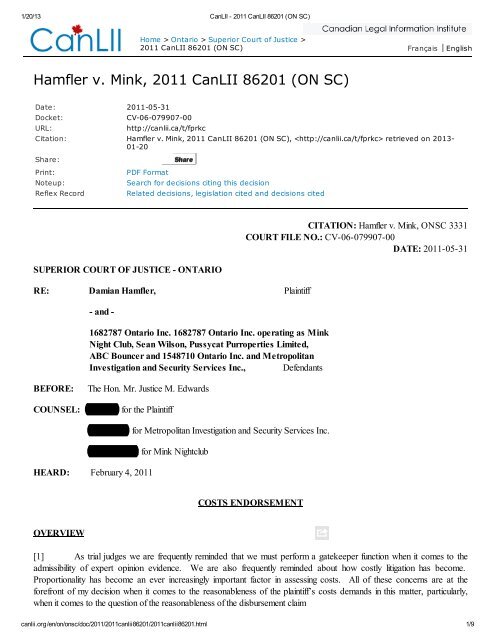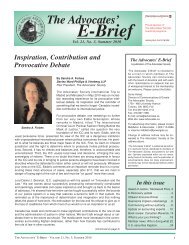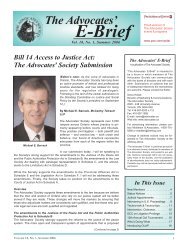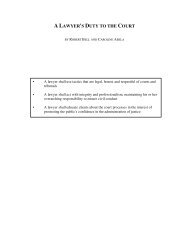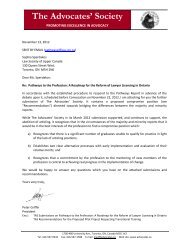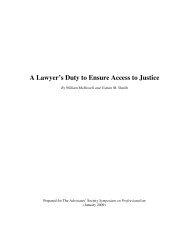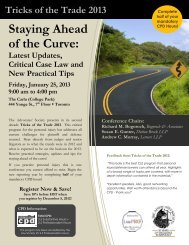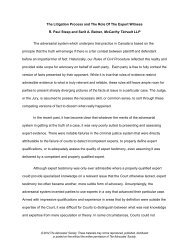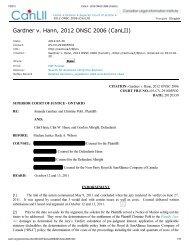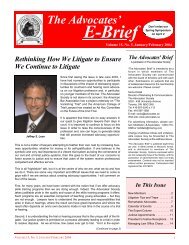Hamfler v. Mink, 2011 CanLII 86201 (ON SC) - The Advocates' Society
Hamfler v. Mink, 2011 CanLII 86201 (ON SC) - The Advocates' Society
Hamfler v. Mink, 2011 CanLII 86201 (ON SC) - The Advocates' Society
You also want an ePaper? Increase the reach of your titles
YUMPU automatically turns print PDFs into web optimized ePapers that Google loves.
1/20/13 <strong>CanLII</strong> - <strong>2011</strong> <strong>CanLII</strong> <strong>86201</strong> (<strong>ON</strong> <strong>SC</strong>)material issue?[18] <strong>The</strong>se are just some of the questions that a trial judge may ask and which I have asked myself with respect to thenecessity and reasonableness of the plaintiff’s bill of costs and in particular the list of disbursements. Fundamentallyhowever, the court must as I have done, direct itself to the question of whether the amount claimed is fair and reasonable.An expert can simply not charge what he or she considers appropriate and then expect through counsel that such fee will bedeemed acceptable by the court. Reasonableness and fairness will dictate whether a disbursement, and in this case, whetheran expert’s fee is assessable in whole or in part.DISBURSEMENT CLAIM OF MR. HAMFLER[19] <strong>The</strong> plaintiff in this matter chose to put before the court expert opinion evidence of various doctors. <strong>The</strong>se includedDr. Garber who was qualified as a clinical psychologist; Dr. Berbrayer who was qualified as a physiatrist; and Dr. Schererwho was qualified as a vocational psychologist. For reasons that perhaps are best known to the plaintiff, no evidence wascalled from any treating doctors. <strong>The</strong> plaintiff suffered a nasty facial injury as a result of what the jury clearly viewed as theunprovoked use of force against the plaintiff involving bouncers and/or security staff at the <strong>Mink</strong> Nightclub. <strong>The</strong> facial injuryrequired an operative procedure that left the plaintiff with some residual facial deformity. All in all, the plaintiff came out ofthe acute phase post incident with a good operative result. He was off work for a relatively short period of time andultimately he changed jobs.[20] In addition to the aforementioned medical doctors the plaintiff also called expert evidence from an economist-Mr.Durani; as well as a life care planner Ms. Nowitz who testified about the plaintiff’s future care needs and housekeepingneeds.[21] <strong>The</strong> plaintiff’s tax returns did not reveal any substantial change in his overall level of income but, nonetheless, theplaintiff chose to call an economist to suggest that he had suffered a very substantial past income loss and would suffer asubstantial loss of income in the future. On all accounts the jury in this case chose to almost completely reject the theory putbefore them as it related to the plaintiff’s claim for loss of income both past and future. Mr. Durani suggested the plaintiffhad suffered a past loss of income of approximately $127,000. He then presented 3 scenarios as the basis to calculate anaward for the plaintiff’s future loss of income. <strong>The</strong>se scenarios ranged from a low of $183,000 to a high of $893,000. <strong>The</strong>jury ultimately awarded the sum of $30,000 for future loss of income. It is worth reflecting on this award for future loss ofincome as it is only slightly more than one half of what the plaintiff was earning as an annual salary as of the date of trial.[22] Where a jury is told by the plaintiff’s economist that the plaintiff’s past loss of income was $127,000 and the futureloss of income could range from a low of $183,000 to a high of $893,000 and the jury then returns a verdict of $15,000 forpast loss of income and $30,000 for future loss of income, I, as the trial judge, must ask a fundamental question as to howuseful, if at all, the evidence of the economist was to the jury. This is especially so when the economist was of absolutely noassistance to the jury as to how one calculates the present value of a dollar. <strong>The</strong> jury was left completely in the dark as tohow to perform this fundamental calculation. Regrettably, I have come to the conclusion as it relates to the evidence of theMr. Durani that his evidence was of very little use to the jury.[23] As will become apparent later in my reasons, the plaintiff’s bill of costs as it relates to the legal fees claimed was forthe most part quite reasonable. <strong>The</strong> disbursements are another matter. I have already indicated that the evidence of Mr.Durani was of very little assistance to the court. <strong>The</strong> plaintiff’s bill of costs reflected a total claim for Mr. Durani of $5,460.I have allowed $2,500 for Mr. Durani’s costs to reflect the very limited assistance he was to the court and the fact hecompletely failed to give the jury the tools it would need to do a present value calculation. Such an omission is glaring andcannot be excused. It warrants a substantial reduction in the amount claimed on account of Mr. Durani’s services.[24] I then move to the disbursement list as it relates to the medical experts. As previously noted, the plaintiff chose toprove this aspect of his case through medical legal experts as opposed to treating doctors. In so doing, the plaintiff chosewhat can only be described as a Cadillac approach to the proof of the plaintiff’s damages claim. I was provided withabsolutely no assistance from the plaintiff as to how the various medical doctors arrived at the amount they charged for thecanlii.org/en/on/onsc/doc/<strong>2011</strong>/<strong>2011</strong>canlii<strong>86201</strong>/<strong>2011</strong>canlii<strong>86201</strong>.html 5/9
1/20/13 <strong>CanLII</strong> - <strong>2011</strong> <strong>CanLII</strong> <strong>86201</strong> (<strong>ON</strong> <strong>SC</strong>)preparation of their reports and attendance at trial. While I appreciate that plaintiff’s counsel may feel compelled to pay theaccount of an expert as submitted to them, that does not mean that the court will simply rubber stamp the expert’s invoice.<strong>The</strong> court requires something more than a list of disbursements.[25] If counsel expects the court to perform its function in assessing the reasonableness of an expert’s fee, there is anobligation on counsel to place before the court information that will allow the court to perform that function. <strong>The</strong> type ofinformation that would assist in this regard may include the amount of time spent by the expert in preparing the report andattending at trial (including preparation time) together with the hourly rate of the expert. As it relates to an expert’s hourlyrate, again, I would suggest this should not simply be a rubber stamp approach. <strong>The</strong> court should be provided (if it isavailable), with information from an expert’s governing body as to appropriate hourly rates. Alternatively, if this informationis not available, then comparable hourly rates of other experts in the same field may be of assistance. It may also be thecase that an expert, like a doctor, may have to cancel part or all, of his days schedule such as his patients. This would be arelevant factor in considering the reasonableness of the total fee charged by an expert.[26] In assessing the reasonableness of the claims for various experts in Robert v. Morana, supra, O’Brien J. hadbefore him, information about hourly rates and hours worked by the experts. <strong>The</strong> accounts were detailed and this allowedO’Brien J. to perform an appropriate assessment of the reasonableness of the claim made by the experts whose accountshad been paid by plaintiff’s counsel. None of this type of information was before me. I note that in 3664902 Canada Inc.et al v. Hudson’s Bay Co. 2003 <strong>CanLII</strong> 26101 (<strong>ON</strong> CA), 2003 <strong>CanLII</strong> 26101 (<strong>ON</strong> C.A.), the Ontario Court of Appealappears to have endorsed an approach that the assessment of disbursements including witness fees should be on the basis ofwhat was actually spent, reduced if appropriate to what is reasonably spent.[27] In this case a comparison of the amounts charged by comparable experts is very enlightening. Dr. Garber wasqualified as a clinical psychologist; Dr. Scherer as a vocational psychologist. Dr. Garber submitted invoices reflected on thelist of disbursements as follows: medical report $12,850 and court attendance/preparation $16,775.00. Dr. Scherersubmitted the following: medical report $3,350 and court attendance/preparation $4,020.53. When this discrepancybetween these 2 comparable experts-both called by the plaintiff, was brought to the attention of plaintiff’s counsel inargument, he had no explanation as to why such a substantial discrepancy was justified other than the obvious, this was theamount Dr. Garber had charged for his services. In the absence of any evidence as to why Dr. Garber’s invoices should beviewed differently than Dr. Scherer’s, I have simply allowed $4,500 for Dr. Garber’s report and $4,000 for his attendanceand preparation for trial.[28] <strong>The</strong> plaintiff’s list of disbursements included costs incurred with Dr. Henry Berry. <strong>The</strong>se included $4,500 for areport and $3,000 for court attendance. Dr. Berry is a very well known and eminently qualified expert in the field ofneurology, internal medicine and psychiatry. At the beginning of the trial, plaintiff’s counsel sought to call more than 3 expertwitnesses. While the plaintiff was allowed to call more than 3 experts, I disallowed the evidence of Dr. Berry as hisevidence was largely going to overlap with the evidence of Drs. Garber and Scherer. Counsel cannot simply assume thatthe court will allow for the calling of more than 3 experts; this is particularly so today when trial judges are constantlyreminded of how the costs of litigation are so high. If counsel takes the risk of engaging the services of more than 3 experts,he or she cannot assume that those costs will ultimately be borne by the losing party. Only if leave is granted to call morethan 3 experts and an expert is then called at trial will those additional costs become assessable as reasonable. In this case,Dr. Berry was not allowed to testify and as such none of his costs are a reasonable disbursement that the defence shouldhave to pay for.[29] I then move to the disbursements of Dr. Berbrayer and the life care planner or future care expert Ms. Nowitz. BothDr. Berbrayer and Ms. Nowitz work through the auspices of a company called MDAC. Unfortunately, the list ofdisbursements does not provide much assistance as to what the MDAC invoices specifically relate to. <strong>The</strong> total claimed forMDAC comes to $15,568. In addition, the list of disbursements provides for the following: Dr. Berbrayer’s medical report$1,275, Dr. Berbrayer court attendance/preparation $4,020.53. <strong>The</strong>re is also a disbursement for MDAC, LaurianNowitz’s - court attendance/preparation $1,275. <strong>The</strong> total for MDAC, Dr, Berbrayer and Ms. Nowitz comes to $22,518.I have no difficulty with the amounts claimed for Dr. Berbrayer’s report of $1,275, nor do I have any difficulty with his courtcanlii.org/en/on/onsc/doc/<strong>2011</strong>/<strong>2011</strong>canlii<strong>86201</strong>/<strong>2011</strong>canlii<strong>86201</strong>.html 6/9
1/20/13 <strong>CanLII</strong> - <strong>2011</strong> <strong>CanLII</strong> <strong>86201</strong> (<strong>ON</strong> <strong>SC</strong>)attendance of $4,400. Similarly, I have no difficulty with the court attendance for Ms. Nowitz of $1,275. I have beenprovided with little to no assistance with respect to the additional time claimed by MDAC totalling $15,568. I appreciatethat some of those costs may have included time responding to defence reports and updating reports. I have been givennothing to properly assess the reasonableness of those additional MDAC charges. If counsel wants the court to assessthese types of charges then counsel must put before the court what these charges were for and how the amount has beencalculated. At the very least there should be information about the time spent and hourly rates. <strong>The</strong> court expects this fromthe lawyers in relation to their claim for partial or substantial indemnity costs. I see no reason why we should not expect thisfrom an expert. Doing the best that I can with the limited information available, I have allowed $10,000 for the MDACcharges.[30] I have briefly touched on the charges of Dr. Scherer. <strong>The</strong>se were for a report that was invoiced at $3,350 andcourt attendance of $4,020.53. When compared with the invoiced charges of Dr. Garber at $12,850 and $16,775 for hisreport and court attendance, I have no difficulty allowing the claims for Dr. Scherer, although it would again be helpful tohave more information about what time Dr. Scherer spent on his report together with his hourly rate.[31] This then leaves a number of smaller items on the list of disbursements. A claim is made to summons the variousexperts retained by the plaintiff to give evidence in this matter. While in the normal course, it is expected that a witness willbe under summons to ensure their attendance at trial, it does not seem reasonable that the losing party should be paying forthe costs of summonsing one or all of the plaintiff’s experts. <strong>The</strong>se experts have been retained and are being paid by theplaintiff to provide their evidence at trial. <strong>The</strong>y should be expected to attend when called and a summons should not berequired. Only in situations where counsel can show that a summons was reasonable would this type of disbursement beconsidered a reasonable disbursement. I have therefore disallowed the costs claimed for summonsing the plaintiff’s experts.[32] <strong>The</strong> plaintiff included in his list of disbursements an item for “Threat Ready” in the amount of $1,679 for “expert casepreparation”. I was provided with no information as to what this related to or any information as to why this was areasonable disbursement. Assuming this relates in some way to the preparation of the various experts, I can only suggestthat this surely is the responsibility of counsel. Counsel is entitled to assess a reasonable amount for preparing for trial whichwould include meeting with and preparing his or her experts. In the absence of some compelling reason to the contrary, Ifail to see how the disbursement for “expert case preparation” can be considered reasonable.[33] <strong>The</strong> list of disbursements included an item for “Designable Environments”- “Future Care Assessment”. I havealready allowed an amount for the life care planner/future care expert Ms. Nowitz. No evidence was called throughDesignable Environments. This is not a proper disbursement. <strong>The</strong> plaintiff also claimed for the cost of a limousine service totransport Dr. Berbrayer and Ms. Nowitz to court. In the overall scheme of things the total for these services of $506 is arelatively small part of the total disbursement claim of approximately $93,000. Nonetheless, whether the claim is small orlarge it must still be seen as reasonable before the losing side should be asked to pay for it in a costs award. <strong>The</strong>re isnothing to suggest that either Ms. Nowitz or Dr. Berbrayer did not have their own personal vehicle to get to court. In theabsence of such evidence that might then justify a limousine service or taxi, I am allowing a reasonable mileage charge forboth experts of $80 each.[34] As previously noted, the plaintiff submitted a list of disbursements totalling approximately $93,000 inclusive of GSTand HST. For the reasons set forth above, I have allowed a total of $51,000 for the plaintiff’s disbursements which isinclusive of GST and HST.LEGAL FEES[35] I have already commented briefly on the plaintiff’s bill of costs as it relates to the claim for legal fees. In total a claimis submitted for $87,680 plus HST of $10,400 for a total of $99,078.40. <strong>The</strong> claim as submitted was on a partial indemnitybasis. <strong>The</strong> bulk of the time claimed related to the services of Mr. Laing who is a 2005 Call to the Bar. His hourly rateclaimed was $200 per hour. In total Mr. Laing claimed 326 hours at $200 per hour or $65,200. Smaller amounts werealso claimed for other counsel in Mr. Laing’s firm. This is not a case where it can be said there was an “overlawyering” ofthe file. <strong>The</strong> time spent does reflect there was some excess of preparation time but, on the other hand it can be said that thecanlii.org/en/on/onsc/doc/<strong>2011</strong>/<strong>2011</strong>canlii<strong>86201</strong>/<strong>2011</strong>canlii<strong>86201</strong>.html 7/9
1/20/13 <strong>CanLII</strong> - <strong>2011</strong> <strong>CanLII</strong> <strong>86201</strong> (<strong>ON</strong> <strong>SC</strong>)result obtained was a fair result and an important result from Mr. <strong>Hamfler</strong>’s perspective. Given that I was not presentedwith any Rule 49 offer to consider from the defence, I can only assume that the result at trial was better than any offer madeby the defence. Mr. Laing’s hourly rate is reasonable. Mr. Laing’s presentation of the evidence was skilful, even if it didnot result in the quantum of the award he may have hoped for.[36] Some reduction in the total claim for costs must be reflected in the fact that the defence was called upon to defend 3separate actions brought by the 3 sets of plaintiffs who appeared at trial. <strong>The</strong> jury award to Mr. <strong>Hamfler</strong> was notinsignificant. <strong>The</strong> award to Mr. Tomas of $3,000 and to Mr. Borland of $2,000 was less than the limits of the Small ClaimsCourt. While the actions of both Mr. Borland and Mr. Tomas were tried at the same time as Mr. <strong>Hamfler</strong>’s claim, andtherefore did not consume much if any additional court time, I accept the submissions of defence counsel that it wascompletely unnecessary to have 3 separate actions. It would have been a simple task to have a consolidated Statement ofClaim for all 3 plaintiffs particularly where the plaintiffs were all represented by the same firm. With 3 separate claims thedefence was called upon to file separate defences and conduct separate discoveries. <strong>The</strong>re was an unnecessary increase indisbursements and legal fees caused by the institution of the 3 separate claims.[37] While the award to Mr. Tomas and Mr. Borland was less than the Small Claims Court limits, I am not prepared toaward the costs of the trial for their claims to the defence. Prima facie the defence would be entitled to such a costsaward. <strong>The</strong> amount of time at trial spent on their respective claims was, however, negligible. Mr. Tomas and Mr. Borlandwould have had to testify, regardless, as they were key eye witnesses to what occurred on the night of February 26, 2006.I make no award for their costs, but do reflect some reduction in the overall claim for legal fees asserted in the Bill of Coststo reflect needless duplication by commencing 3 separate actions. In total I allow the plaintiff’s costs fixed in the amount of$77,500 inclusive of HST.DISBURSEMENT CLAIMS OF MR. TOMAS AND MR. BORLAND[38] As I have already noted these claims should not have been the subject matter of 3 separate Statements of Claimwhere all 3 plaintiffs were represented by the same law firm. <strong>The</strong> disbursement costs for the issuance of the claims forBorland and Tomas as well as the LSUC Levy fee, additional trial record fees ,and fees to issue 3 jury notices wasunnecessary and could have been avoided if one statement of claim had been issued. I therefore disallow those additionaldisbursements reflected in the Borland and Tomas list of disbursements.[39] <strong>The</strong>re is a disbursement cost for a Dr. Langer on the Borland list of disbursements. Dr. Langer was not called as anexpert. Dr. Langer is I believe an orthopaedic doctor. Given Mr. Borland’s evidence at trial that he was off work only fora few days, one may question why Dr Langer was involved in this matter at all. Surely if Mr. Borland was injured (and hisown evidence, to his credit, left one with the impression he had very minor injuries), the first avenue to prove those damagesare his treating doctor(s) not a medical legal referral. I see no basis to allow the claim for Dr. Langer's disbursement.[40] <strong>The</strong> list of disbursements for Mr. Borland includes an amount for a private mediation. I have allowed some part ofthat mediation cost in the <strong>Hamfler</strong> list of disbursements as it is more properly assessable for his claim than that of either Mr.Tomas or Mr. Borland. <strong>The</strong>re are also the usual claims for photocopying, postage, courier and facsimiles. For the mostpart, these are subject to the similar duplication argument that I have referenced above.[41] <strong>The</strong> total disbursement claim of Mr. Borland is allowed in the amount of $550.[42] <strong>The</strong> disbursements of Mr. Tomas are subject to the same reductions and for the same reasons as what I havealready stated regarding Mr. Borland’s list of disbursements. <strong>The</strong> disbursement of Mr. Tomas is allowed in the amount of$200.canlii.org/en/on/onsc/doc/<strong>2011</strong>/<strong>2011</strong>canlii<strong>86201</strong>/<strong>2011</strong>canlii<strong>86201</strong>.html 8/9
1/20/13 <strong>CanLII</strong> - <strong>2011</strong> <strong>CanLII</strong> <strong>86201</strong> (<strong>ON</strong> <strong>SC</strong>)Edwards J.Date Released: May 31, <strong>2011</strong>Scope of Databases Tools Terms of Use Privacy Help Contact Us Aboutby for the Federation of Law Societies of Canadacanlii.org/en/on/onsc/doc/<strong>2011</strong>/<strong>2011</strong>canlii<strong>86201</strong>/<strong>2011</strong>canlii<strong>86201</strong>.html 9/9


